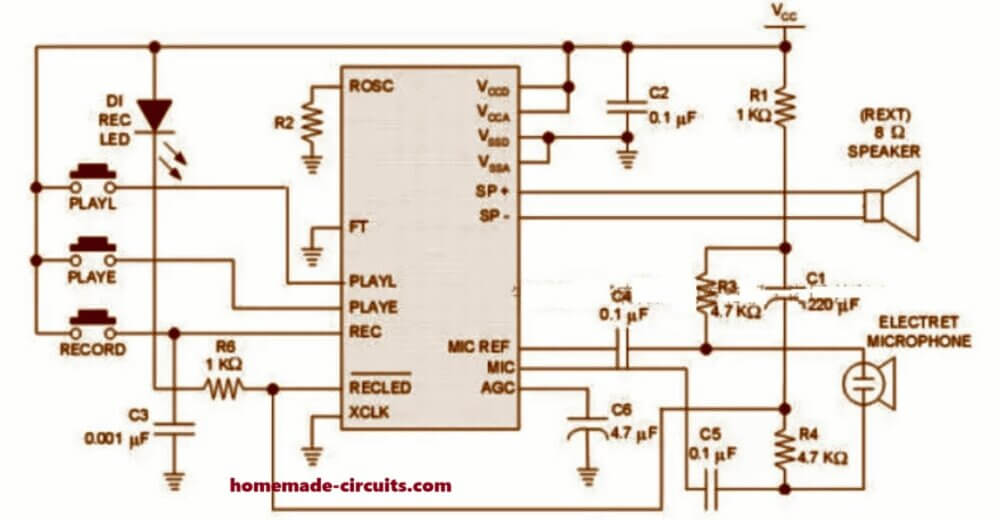The ISD1820 is a voice IC that lets us record voice from a mic and play it back using simple buttons or microcontroller. We can record between 8 to 20 seconds which depends on how we set it.
This IC is used in small voice projects, talking toys, greeting circuits, voice alerts, and more.
ISD1820 Pinout

Recording Time and Quality (Based on ROSC Resistor)
| Resistor Value (ROSC) | Recording Time | Sampling Rate | Audio Quality |
|---|---|---|---|
| 80kΩ | 8 seconds | 8.0kHz | 3.4kHz |
| 100kΩ | 10 seconds | 6.4kHz | 2.6kHz |
| 120kΩ | 12 seconds | 5.3kHz | 2.3kHz |
| 160kΩ | 16 seconds | 4.0kHz | 1.7kHz |
| 200kΩ | 20 seconds | 3.2kHz | 1.3kHz |
So the larger the resistor, the longer the record time, but then sound quality goes down.
Pin Descriptions (in crude simple way)
- VCC → Connect 3V to 5V power supply here.
- VSSA / VSSD → Ground pins for analog and digital parts.
- REC → When this pin goes high (like pressing a button), then recording starts. It stops when REC goes low or memory becomes full.
- PLAYE (Edge Trigger) → If this pin gets a rising signal (like button press), then it plays the whole message once.
- PLAYL (Level Trigger) → It plays only when this pin is high. So press and hold = play, release = stop.
- /RECLED → Goes LOW when recording. Can connect to LED to show recording. It also gives a pulse at end of playback.
- MIC → Connects to external microphone (goes to internal amplifier).
- MICREF → Reference pin for MIC. Helps cancel noise.
- AGC → Automatic Gain Control. Use capacitor (like 4.7uF) here to adjust voice volume handling.
- SP+ / SP- → Connect directly to 8Ω speaker. Works like mono speaker output.
- ROSC → Connect resistor here to control recording time.
- FT (Feed Through) → When this pin is HIGH, then voice from mic goes straight to speaker (like loudspeaker/megaphone mode).
Circuit Diagram

How to Use – Step by Step
To Record:
- Press and hold REC button.
- The LED connected to /RECLED will light up.
- Speak into mic.
- Release button to stop recording.
To Play:
- Press PLAYE once → message plays completely.
- Press and hold PLAYL → plays only while button is held.
To Loop the Message:
- Connect a switch to loop mode circuit.
- Press PLAYE, then message keeps repeating.
- Only way to stop = turn off power.
Feedthrough Mode (Live Mic to Speaker)
- Make FT pin HIGH.
- Keep REC, PLAYE, PLAYL all LOW.
- Now mic will send sound directly to speaker, like a megaphone.
- Sound is clean and auto-adjusted by AGC, does not distort easily.
Tips:
- If you want super low power then you can wire mic circuit so it only gets power during recording.
- For stronger sound you can add external amplifier like LM386, TA7368, D2822, etc.
- Signal comes out from SP+ or SP- through a capacitor.
- The unused speaker pin must be left unconnected, not grounded.
Applications:
- Can be used for door greeting, talking toys, alarms, reminder boxes.
- Easy to connect with Arduino or microcontroller.
- Best to use 5V regulated power for stable voice quality.
Need Help? Please Leave a Comment! We value your input—Kindly keep it relevant to the above topic!